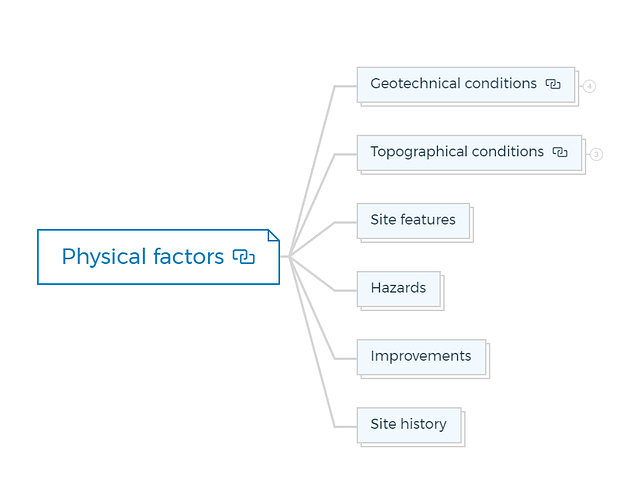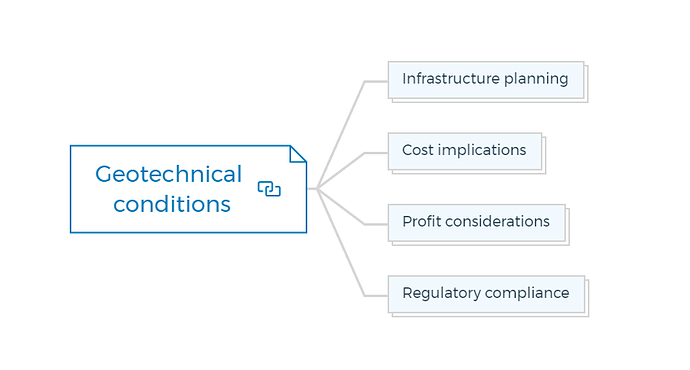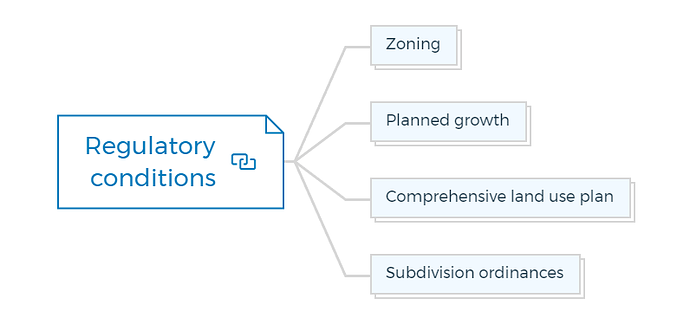1. Physical factors
1.1. Geotechnical conditions
Geotechnical conditions refer to the natural characteristics of the site, including its soil, geology, and water-related properties. These conditions have a significant impact on the costs and feasibility of land development projects. Here’s how they matter:
Infrastructure planning
Geotechnical conditions influence the infrastructure needed for managing stormwater, constructing roads, laying building foundations, and designing utilities.
Cost implications
Poor geotechnical conditions can substantially increase the cost of installing infrastructure, potentially making homes unaffordable for the intended market.
Profit considerations
Development costs can erode project profits or even make them non-existent if geotechnical challenges are not addressed effectively.
Regulatory compliance
Environmental regulations may restrict certain construction activities, posing additional challenges.
1.2. Topographical conditions
Terrain type (flat, hilly, sloped)
This refers to whether the land is predominantly flat, hilly, or sloped. Each terrain type presents unique challenges and opportunities for development.
Elevation above sea level
Elevation provides information about how high or low the land is relative to sea level. Elevation affects various aspects of development, including flood risk assessment, foundation design, and access to utilities.
Natural drainage patterns
Understanding the natural flow of water across the land is essential for effective drainage planning. It helps determine where water will collect and potentially cause flooding or erosion issues.
1.3. Site features
- Unique natural features (water bodies, forests, etc.)
- Existing structures or improvements
- Vegetation and wildlife
1.4. Hazards
- Identification of potential natural hazards (floods, earthquakes, etc.)
- Mitigation plans for hazards
1.5. Improvements
- Infrastructure availability (water, electricity, gas, sewage)
- Road access and conditions
- Telecommunications infrastructure
1.6. Site history
- Historical significance
- Previous land use and development
You are missing out if you haven’t yet subscribed to our YouTube channel.
2. Legal and political factors
2.1. Regulatory conditions
2.1.1. Zoning
Zoning regulations are a critical legal aspect that directly impacts your land’s suitability for your intended purpose. Here’s why zoning matters:
Defining land use
Zoning classifications outline how the land can be used, including the type of development and building placement.
Development limits
Zoning imposes constraints on factors such as building height, setbacks, easements, and the portion of the site that can be occupied by structures.
Alignment with project
Your project must conform to the specific requirements outlined in the zoning classification.
Learn More
2.1.2. Planned growth
Planned growth strategies involve carefully regulating the timing, pace, and location of development in consideration of available infrastructure and the physical characteristics of the area. Key aspects of planned growth include lot sizes, population density, and road widths.
2.1.3. Comprehensive land use plan
- Alignment with comprehensive plans and zoning
2.1.4. Subdivision ordinances
Obtain a copy of the local subdivision ordinance after you secure the correct zoning classification.
2.2. Political conditions
2.2.1. Community’s attitude
Understanding and positively influencing the community’s attitude is crucial for project approval. City and county commissioners pay close attention to public opinion, often through public hearings. Here’s how to navigate this aspect:
- Positive addition: Present your project as a valuable addition to the community.
2.2.2. Winning community support
Gaining community support can be challenging, but it’s essential for project success. Potential issues may include:
- Local significance
If your land holds special meaning for local groups, approach changes with sensitivity.
- Highly developed area
In densely developed areas, address concerns about traffic, population, and environmental impact.
- Engage early
Meet with city and county planners to understand community concerns. Attend meetings of interest groups and neighborhood associations to gauge reactions.
- Mitigation strategies
Listen to concerns and develop strategies to address them.
- Inform and educate
Provide accurate information to counter misinformation. Address legitimate concerns to build a positive image.
- Persistence
If opposition persists, evaluate the project’s viability. Consider flexible land purchase agreements contingent on local government approval.
3. Offsite factors
Offsite factors play a significant role in influencing your project’s market appeal. Here’s how they can impact your development:
3.1. Enhancing factors
Proximity to attractions like parks, waterfront areas, or popular shopping districts can enhance your project’s desirability, particularly if your target market values these adjacent land uses.
3.2. Utility accessibility
The availability of sufficient utilities for homeowners is another positive offsite factor that can add value to your project.
3.3. Road and street conditions
The condition of roads and streets surrounding your development is a critical consideration for offsite factors.
3.4. Negative influences
Negative offsite factors tend to have a more pronounced impact on project viability. These factors include security concerns in the area, adverse environmental effects from nearby land uses, and land uses associated with crime, health risks, or traffic congestion.
3.5. Undesirable and uses
Undesirable land uses may result in offensive odors, excessive noise, or undesirable views. It’s essential to carefully assess the potential effects of proximity to such factors as industrial zones, transmission lines, or landfills.
3.6. Mitigation strategies
If negative offsite factors are present, consider strategies such as noise buffering, ensuring safe access, or obstructing unwanted views.
3.7. Target market consideration
Evaluate the impact of each negative offsite factor on your intended target market, as different groups may have varying tolerances for these factors.
3.8. Cost assessment
Assess the costs and feasibility of mitigating negative offsite characteristics.










